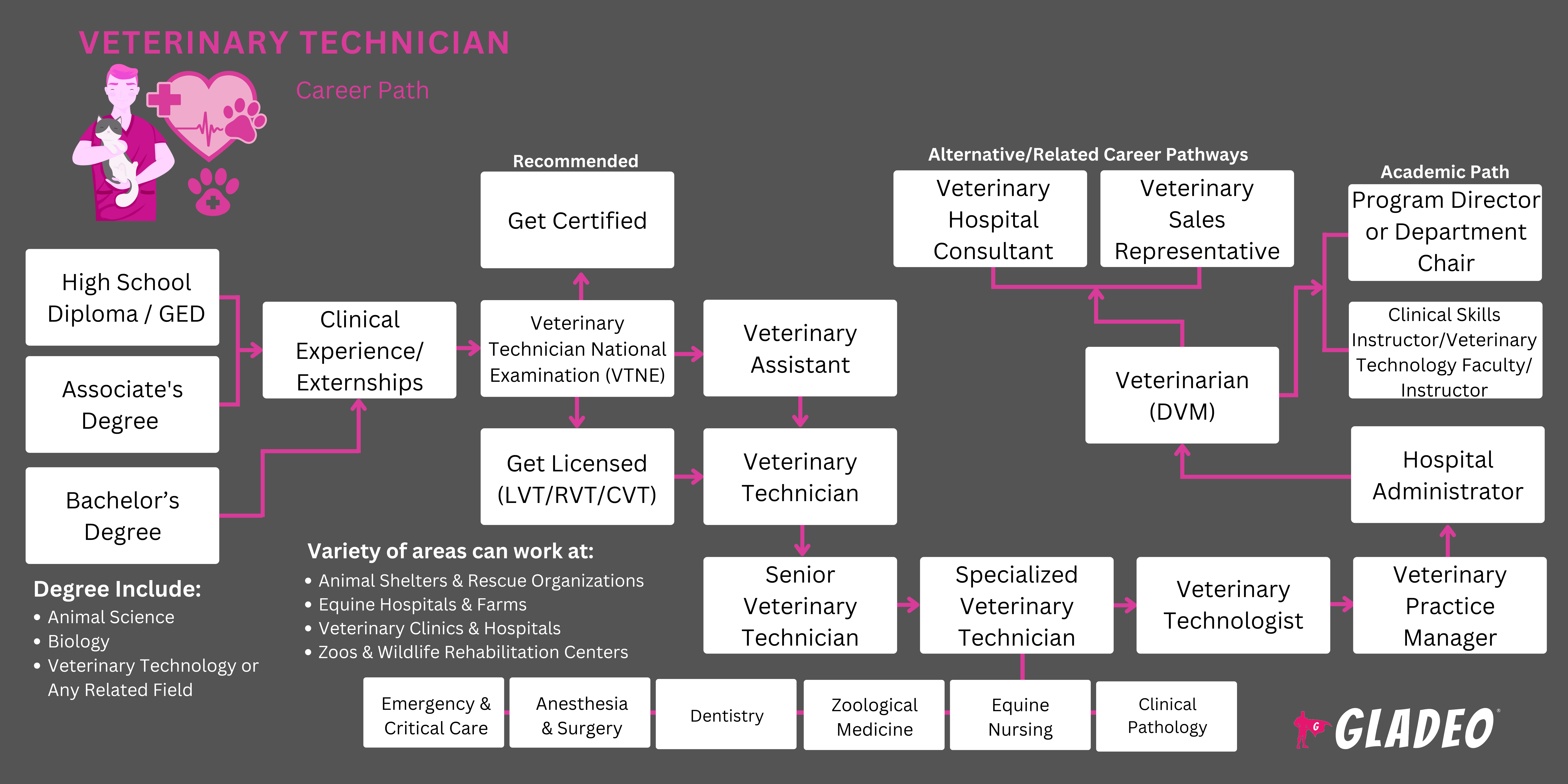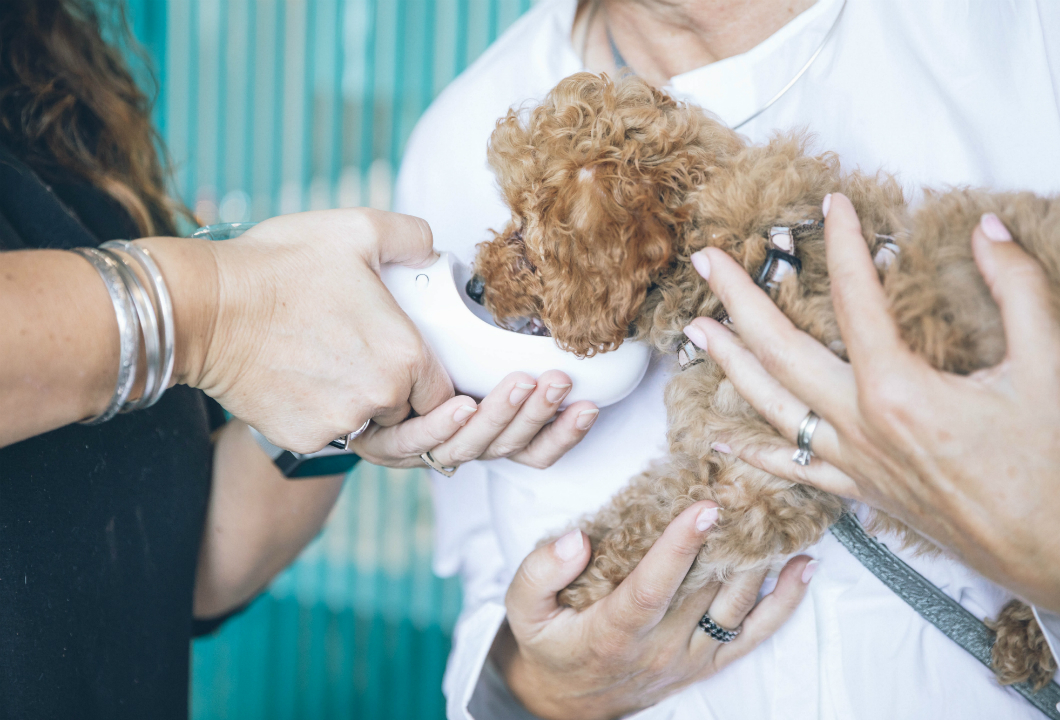Spotlights
Kỹ thuật viên thú y được chứng nhận (CVT), Kỹ thuật viên thú y cấp cứu (Emergency Vet Tech), Kỹ thuật viên thú y nội khoa (Internal Medicine Vet Tech), Kỹ thuật viên thú y được cấp phép (LVT), Kỹ thuật viên thú y đã đăng ký (RVT), Kỹ thuật viên thú y (Vet Tech), Kỹ thuật viên phòng thí nghiệm thú y (Vet Lab Tech), Y tá thú y (Vet Nurse), Kỹ thuật viên thú y (Vet Tech), Kỹ thuật viên thú y
Các nhà công nghệ và kỹ thuật viên thú y thực hiện các xét nghiệm y tế giúp chẩn đoán thương tích và bệnh tật của động vật.
- Chăm sóc động vật
- Làm việc với động vật
- Mỗi ngày đều khác nhau!
- Quan sát hành vi và tình trạng của động vật
- Cung cấp dịch vụ chăm sóc y tế hoặc sơ cứu khẩn cấp cho động vật đang hồi phục hoặc bị thương
- Tắm cho động vật, cắt móng hoặc vuốt, chải hoặc cắt lông cho động vật
- Hạn chế động vật trong quá trình khám hoặc thủ thuật
- Tiến hành gây mê cho động vật và theo dõi phản ứng của chúng
- Chụp X-quang và thu thập và thực hiện các xét nghiệm trong phòng thí nghiệm, chẳng hạn như xét nghiệm nước tiểu và công thức máu
- Chuẩn bị động vật và dụng cụ cho phẫu thuật
- Quản lý thuốc, vắc-xin và phương pháp điều trị theo chỉ định của bác sĩ thú y
- Thu thập và ghi lại lịch sử bệnh lý của động vật
- Kỹ năng giao tiếp
- Lòng thương
- Chú ý đến chi tiết
- Sự khéo léo của bàn tay
- Sức mạnh thể chất
Kỹ thuật viên thú y thường làm việc tại các phòng khám tư nhân hoặc bệnh viện thú y dưới sự hướng dẫn của bác sĩ thú y được cấp phép.
Các kỹ thuật viên thú y thường làm việc trong các công việc nghiên cứu nâng cao hơn, thường dưới sự hướng dẫn của một nhà khoa học hoặc bác sĩ thú y. Một số kỹ thuật viên làm việc tại các phòng khám tư nhân, chủ yếu trong môi trường phòng thí nghiệm.
- Đòi hỏi về mặt thể chất hoặc tinh thần
- Nguy cơ bị thương khi làm việc. Họ có thể bị cắn, cào hoặc đá khi làm việc với những con vật sợ hãi hoặc hung dữ.
- Có thể làm việc vào cuối tuần và buổi tối.
- Động vật được yêu thích
- Giúp đỡ bạn bè hoặc thành viên gia đình khi họ bị thương
- Kỹ thuật viên thú y thường cần có bằng liên kết về công nghệ thú y
- Lưu ý rằng các nhà công nghệ và kỹ thuật viên có yêu cầu về trình độ học vấn khác nhau. Một "nhà công nghệ" cần có bằng cử nhân.
- Các chương trình công nghệ thú y thường có quyền truy cập vào các khu vực nơi sinh viên có thể làm việc trực tiếp với động vật trong khuôn viên trường, cũng như tại các bệnh viện và phòng khám thú y thông qua các chương trình thực tập.
- Chương trình của Cao đẳng Cộng đồng Portland liệt kê các chủ đề mà sinh viên sẽ tìm hiểu, chẳng hạn như:
- cách tiêm vắc-xin và dùng thuốc
- thực hiện chăm sóc răng miệng
- thu thập mẫu chẩn đoán
- giáo dục chủ sở hữu về hành vi động vật
- duy trì thuốc men và hàng tồn kho
- chuẩn bị bệnh nhân cho phẫu thuật
- phát triển phim chụp X-quang
- Các chương trình phải được công nhận bởi Hiệp hội Y khoa Thú y Hoa Kỳ , nơi cung cấp danh sách các chương trình đại học được công nhận tại đây
- Sau khi tốt nghiệp, Kỹ thuật viên thú y phải vượt qua Kỳ thi quốc gia dành cho Kỹ thuật viên thú y (do Hiệp hội các Hội đồng Thú y cấp tiểu bang Hoa Kỳ, hay AAVSB, quản lý) để có thể làm việc tại hầu hết các tiểu bang.
- Bài thi có 150 câu hỏi (cộng thêm 20 câu hỏi "thử nghiệm" không tính điểm). Thí sinh có ba giờ để hoàn thành bài thi.
- Điểm thi được chấm từ 200 - 800. 425 là điểm đậu tối thiểu
- Tỷ lệ đậu rất khác nhau, vì vậy điều quan trọng là phải chọn một chương trình đào tạo tốt và học tập chăm chỉ. Nhiều sinh viên mua tài liệu học tập tùy chọn
- Sinh viên có thể sử dụng công cụ Hội đồng cấp phép thú y của ASVSB để tìm thông tin liên hệ với hội đồng của tiểu bang mình
- Các lựa chọn chứng nhận bổ sung bao gồm:
▸ Kỹ thuật viên Nội khoa Thú y - Ung bướu
▸ Kỹ thuật viên Nội khoa Thú y - Nội khoa Động vật Lớn
▸ Kỹ thuật viên Nội khoa Thú y - Học viện Nội khoa Tim mạch dành cho Kỹ thuật viên Thú y
▸ Kỹ thuật viên Nội khoa Thú y - Học viện Nội khoa Thú y dành cho ▸ Kỹ thuật viên Thú y
▸ Kỹ thuật viên Nội khoa Thú y - Học viện Nội khoa Thần kinh dành cho Kỹ thuật viên Thú y
- Học viện Kỹ thuật viên Dinh dưỡng Thú y - Chuyên gia Kỹ thuật viên Thú y - Dinh dưỡng
- Hiệp hội Khoa học Động vật Thí nghiệm Hoa Kỳ -
▸ Kỹ thuật viên động vật thí nghiệm
▸ Kỹ thuật viên động vật thí nghiệm
▸ Trợ lý Kỹ thuật viên Động vật Thí nghiệm
- Hiệp hội các Hội đồng Thú y Tiểu bang Hoa Kỳ - Kỳ thi Quốc gia Kỹ thuật viên Thú y
- Học viện Bệnh lý Thú y Hoa Kỳ - Bệnh lý Giải phẫu Thú y Giai đoạn II
- Hiệp hội thợ rèn ngựa Hoa Kỳ -
▸ Thợ rèn ngựa được chứng nhận
▸ Thợ rèn ngựa được chứng nhận Hiệp hội thợ rèn ngựa Hoa Kỳ
▸ Thợ đóng móng ngựa được chứng nhận - Chứng nhận điều trị
▸ Thợ rèn ngựa được chứng nhận - Chứng nhận của các nhà giáo dục
▸ Thợ rèn ngựa được chứng nhận
▸ Thợ rèn ngựa được chứng nhận - Chứng nhận Forging
- Hiệp hội Nha khoa Ngựa Quốc tế - Kỹ thuật viên Nha khoa Ngựa được Chứng nhận
- Hiệp hội Quản lý Bệnh viện Thú y - Quản lý Thực hành Thú y được Chứng nhận
- Tham gia các lớp học chuẩn bị vào đại học ở trường trung học, bao gồm sinh học, hóa học và toán học
- Hãy cân nhắc việc tham gia giáo dục thể chất hoặc phát triển một thói quen tập thể dục để bạn có đủ sức mạnh để nâng một số động vật khi cần thiết
- Đừng bỏ qua việc phát triển các kỹ năng mềm của bạn, chẳng hạn như giao tiếp và "cách cư xử bên giường bệnh". Những người chủ vật nuôi rất gắn bó và thường coi vật nuôi của mình như thành viên trong gia đình
- Tích lũy càng nhiều kinh nghiệm làm việc với động vật càng tốt, thông qua hoạt động tình nguyện, công việc bán thời gian tại trang trại hoặc trại động vật, hoặc thậm chí là chải chuốt cho thú cưng!
- Hãy tạo dựng mối quan hệ trong thời gian thực tập. Họ có thể cần bạn trở lại làm việc toàn thời gian sau khi bạn tốt nghiệp và vượt qua kỳ thi chứng chỉ.
- Thực hiện tốt các quy trình an toàn khi làm việc với động vật để đảm bảo không ai bị thương — kể cả chính động vật. Động vật rất dễ hoảng sợ, khiến chúng cắn, cào hoặc đá bất kỳ ai ở gần. Ngoài ra, còn có nguy cơ tự làm mình bị thương khi nhảy khỏi bàn hoặc chạy ra khỏi văn phòng.
- Hãy xem liệu bạn có thể theo dõi một Kỹ thuật viên thú y đang làm việc trong một hoặc hai ngày để tìm hiểu thói quen làm việc của họ không
- Xem trước các quảng cáo việc làm tại địa phương để tìm hiểu thêm về các tiêu chuẩn mà nhà tuyển dụng đang tìm kiếm
- Đọc hoặc xem các cuộc phỏng vấn với Kỹ thuật viên thú y và tìm hiểu về các lĩnh vực khác nhau mà họ có thể chuyên về
- Xin lưu ý rằng một số kỹ thuật viên có thể phải thực hiện công việc an tử , tùy thuộc vào tiểu bang nơi người đó được tuyển dụng (và vai trò cụ thể mà người sử dụng lao động giao)
- Tìm hiểu về các yêu cầu cấp phép cụ thể của tiểu bang mà bạn dự định làm việc

- Xây dựng các mối quan hệ vững chắc trong quá trình học tập và thực tập. Đừng ngại ngần hỏi về cơ hội việc làm!
- Hãy đối xử với động vật một cách cẩn thận và kiên nhẫn, đồng thời hãy nhớ đến chủ của chúng! Chủ sở hữu có thể nói tốt về bạn với bác sĩ thú y, nhưng cũng có thể phàn nàn và làm giảm cơ hội được tuyển dụng của bạn.
- Hãy chủ động! Đăng ký nhận thông báo trên các cổng thông tin việc làm như Indeed , Simply Hired và Glassdoor . Tải lên sơ yếu lý lịch/CV của bạn để nhà tuyển dụng dễ dàng tìm thấy bạn hơn. Liên hệ với các nhà cung cấp dịch vụ thú y và các trường cao đẳng địa phương để tìm hiểu về các cơ hội sắp tới.
- Hãy hỏi trường học hoặc chương trình của bạn về bất kỳ nguồn lực tìm kiếm việc làm nào mà họ có thể cung cấp
- Tham khảo các mẫu sơ yếu lý lịch của Kỹ thuật viên thú y để có ý tưởng về định dạng và cách diễn đạt
- Xem lại các câu hỏi phỏng vấn Kỹ thuật viên Thú y mẫu. Hãy chú ý đến những loại câu trả lời mà nhà tuyển dụng có thể mong đợi.
- Hãy thực hành một vài cuộc phỏng vấn thử và nhớ ăn mặc sao cho buổi phỏng vấn thành công !
- Luôn giữ cho phương tiện truyền thông xã hội của bạn chuyên nghiệp
Trang web
- Học viện Y khoa Nội khoa dành cho Kỹ thuật viên Thú y
- Học viện Kỹ thuật viên Nha khoa Thú y
- Học viện Kỹ thuật viên Dinh dưỡng Thú y
- Hiệp hội Bệnh viện Thú y Hoa Kỳ
- Hiệp hội Khoa học Động vật Thí nghiệm Hoa Kỳ
- Hiệp hội các Hội đồng Thú y Tiểu bang Hoa Kỳ
- Học viện Thú y Hoa Kỳ
- Hiệp hội thợ rèn ngựa Hoa Kỳ
- Hiệp hội Bệnh lý Lâm sàng Hoa Kỳ
- Hiệp hội Y khoa Thú y Hoa Kỳ
- Hiệp hội Kỹ thuật viên Thú y Sở thú
- Hiệp hội Nha khoa Ngựa Quốc tế
- Hiệp hội Kỹ thuật viên Thú y Quốc gia Hoa Kỳ
- Hiệp hội Kỹ thuật viên Hành vi Thú y
- Hiệp hội quản lý bệnh viện thú y
Sách vở
- Sách giáo khoa lâm sàng của McCurnin dành cho kỹ thuật viên và y tá thú y , của Joanna M. Bassert VMD
- Toán học y khoa và tính toán liều lượng cho kỹ thuật viên thú y , của Robert Bill
- Cẩm nang tham khảo hàng ngày của Kỹ thuật viên thú y: Chó và mèo , của Candyce M. Jack, Patricia M. Watson, et al.
Nguồn cấp tin tức

Công việc nổi bật

Các khóa học và công cụ trực tuyến







